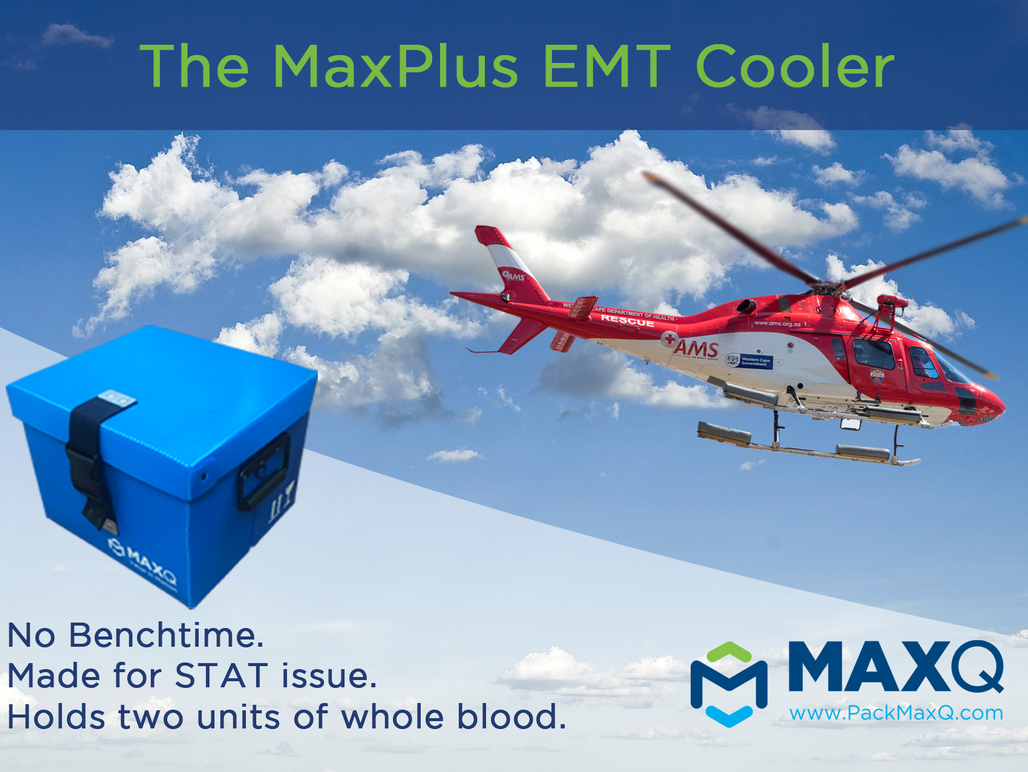Qualified and appropriately sized solutions for emergency medical transport and Air Evac Operations
EMS transport is evolving. For years, EMTs would use saline or colloids for on-site emergency use*, but recent developments and testing have shown that using whole blood in place of these yields better results when dealing with patients who have entered hemorrhagic shock**. Unintentional injury is the leading cause of death for persons aged 1-44***, so it would serve to reason that having easy access to whole blood, RBCs, or platelets would be a priority to help better treat those who have suffered an accident. Helicopters (level 1 trauma services) have adapted blood on board policy, yet it is still uncommon for an ambulance to carry blood products on board*. The main reason for this would be because EMTs would either have to stop at a hospital to pick up spare blood on route (cutting into response time), have blood prepped the day before issue and kept refrigerated (which may not be used and it goes to a bank), or maintain whole blood inventory at operational centers for immediate use (this is the most feasible option)*.
Once the blood units are acquired, transport is still an issue. A cooler that is not specifically made for emergency use can be bulky, take up space, and introduce uncertainty into an emergency situation that operates on precision. Standard foam and plastic molded coolers may not be able to make the trip to the site if they are not filled up with enough ice (or worse, too much ice and the blood goes below freezing) due to ambient temperature and placement inside the emergency vehicle. The cooler may not be able to handle the heat being emitted from an internal engine or battery, for example, and accelerate the melting of the ice inside the cooler. There are still many issues that need to be worked out with the transport of whole blood into emergency situations. Even the current state of the art solutions for EMT employ phase change materials or gel packs that may require up to 20 minutes of room temperature or an elongated refrigerated conditioning (bench time) before they could be packed in the cooler. This represents a deficiency and can limit the STAT issuance of units. Furthermore, the VIP (vacuum insulation panels) employed by the advanced EMT coolers are simply not protected or robust enough to withstand the physical challenges leading to costly insulation replacements and at worst failure during operational use.

The MaxPlus EMT Cooler is qualified for emergency medical transport and Air Evac Operations. Exhibiting an optimized dimensional structure it was designed and qualified for emergency (helicopter, ambulance, etc.) transport. The small form factor (10.25″ x 9.25″ x 9.25″) is ideally suited to fit under most helicopter seats and takes up less space during ambulance use. It can hold two units of whole blood or four units of RBCs/plasma. The cooler itself is qualified for 24 hours of use (21 hours standby, 3 hours in extreme ambient transport) and has no bench time conditioning, so you can leave it packed out and on standby until the need arises. This will allow you to grab and go, getting to emergency sites faster because you aren’t trying to condition the cooler. Its stands up to repeated in-field and in-hospital use. The MaxPlus EMT Cooler is simply a universal (all season) solution for emergency situations.
For additional information, contact us at sales@packmaxq.com.
References:
*Whole Blood in EMS May Save Lives. Andrew D. Fisher, MPAS, PA-C, Max Dodge, BS, NRP, EMT-P, Wren Nealy Jr., Eric A. Bank, LP, NRP, Dominic Thompson, EMT-P. 1 February, 2018.
**Blood on Demand: Designing an EMS Massive Transfusion Program. Dan B. Avstreih, MD, FACEP, FAEMS. John I. Morgan, MD, FACEP. Craig Evans, BA, EMT-P. 25 April, 2019.
***Injuries and Violence Are Leading Causes of Death. Centers for Disease Control and Prevention, National Center for Injury Prevention and Control.




